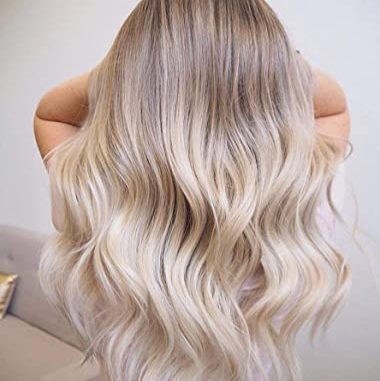
By LINDSEY WAGONER
WARWICK, N.Y.– The coronavirus is changing our world, our daily routines are interrupted. Like clockwork, most customers come into salons every four weeks for their haircut and color when two inches of grey hair protrude from the roots of their scalps. By now many are looking at their hair and wondering “What on Earth am I going to do with this mess?”
With the quarantine heading into its second month of salon closures, local businesses are suffering and there seems to be no end in sight or timeline for businesses to reopen.
Hair salons are among the small community businesses being battered by the closures from the novel coronavirus pandemic. How long can beauty salons sustain before they have to permanently close; how long can salon employees survive without income?
“I have enough money to survive for a little while longer,” said hairstylist Lynne Antonucci, 46, “But after that, I don’t know what I will do.”
Salon closures are threatening the livelihoods of employees. Business owners are not receiving help from government funded programs. Clients are pressuring stylists to make house calls. Hairdressers are struggling financially but for the public’s safety, most stylists are instead staying home.
Director Steve Sleeper of the Professional Beauty Association (PBA) says, “The health and well-being of both the professional salon industry and its clientele is a top priority, and the best way to help ensure that is to practice great salon and personal hygiene always—not just during this public health emergency, but always. This is a great example of why beauty professionals are licensed and that salons are regulated, inspected and have oversight by a state level regulatory body. It’s all there to ensure that the health and safety of everyone in the salon environment and their public customers are protected.”
Financial Hardships
Many Americans are feeling mounting financial pressure and are overwhelmed by the uncertainty in society. In the hairdressing industry- small businesses are taking financial hits, clients fume with desperation over halted business and stylists struggle for newfound ways to make money while keeping employees safe.
On Saturday March 21, 2020 New York State Governor Cuomo, along with governors from New Jersey, Connecticut, and Pennsylvania unilaterally agreed to close all hair salons, barber shops, and nail salons. A public health decision necessary to keep everyone safe. Hair stylists are not able to adhere to a safe social distance while doing their job; it is just not possible.
Hairdressers are left in a tough position, especially financially. Many have no safety net or financial security, it’s mostly a cash-run business. As of December 31, 2017, there were 119,437 active licenses for Cosmetologists in the State of New York, according to the NYS division of licensing services. All professionals who hold a New York State Cosmetology License are currently out of work. This does not include those that hold Nail Specialty Licenses and Esthetician Licenses in the state.
Small businesses are among the hardest hit in the beauty industry. Small businesses are the lifeblood of the U.S. economy and produce two-thirds of new jobs and propel innovative techniques and drive competitive markets. A new report by The Office of Advocacy that sponsored research on small businesses’ contribution to GDP found that small businesses account for 44 percent of economic activity.
Small business owner Nora Pipia, 71, from Talk of the Town Hair Salon has criticized the government for the lack of federal help.
“I cannot get access to any kind of small business loans or any specialized programs. From what I understand, they ran out of money. I can probably carry on for another month or so,” Pipia said. “But after that, this pandemic may force me into retirement. I love my work. I love my salon. I don’t want to close, and I have two other employees to think about.”
With finances increasingly tightening, and the federal government offering little to no help, hairstylists may be forced to do home visits to earn money and make ends meet. Breaking quarantine restrictions endangers the stylist and puts the customer at a higher risk of contracting the virus. The threat also extends to the family members of the stylist and the family members of the customers. Additionally, the more stylists interact with the public, the higher the risk to everyone’s lives. At home haircuts, put a lot of lives at risk, industry observers say.
High Risk House Calls
Because of financial stresses, some hairdressers may have to risk their own health to survive.
Lynne Antonucci an employee at Talk of the Town hair salon in Warwick, N.Y, is struggling with desperate clients begging her to come to their home. A haircut or color is not worth the elevated risk to her health and the danger to her life.
“People keep calling me and asking me to come to their homes. I keep having to tell them, it is not safe for me or for you,” Lynne Antonucci said.
“I cannot believe so many people have asked me to come to their homes. It really is shocking. They are not considering the risk to my life- they just want their hair done. I have clients in their nineties.”
“I don’t want to get them sick either, you don’t know if you’re a carrier. On one hand, I want to be safe and stay healthy,” Antonucci added. “But on the other hand, I may be forced to make home visits depending on how long the closures last. I mean how long can people really go without any income whatsoever?”
Financial Insecurities
Hairstylists are like waitresses and rely on tips and get paid differently than your average occupation.
In this line of work, hairdressers are considered ‘independent contractors.’ They work for themselves and are on their own when it comes to health benefits. Tips are a crucial part of the business. Sometimes a hairdresser will make more money in tips than in salary for the day.
In a salon, hairdressers usually get paid half of what they make for the salon. For example, if you bring in $200 for the business. You get paid $100. Tips are what make a hairdresser’s pay, well, -livable. Most salons do not offer benefits to its employees and there is no legal obligation to do so.
Hairstylists are independent and burdened with finding their own health coverage, which is often at astronomical prices. One hairstylist said the cheapest plan she could find was priced at more than $1,000 a month. It was unrealistic and unfeasible. She opted to go without insurance.
Salon closures are taking its financial toll on employees; while salon customers are taking a mental toll and pressuring hairdressers to reopen their doors.
Customers are angry and desperate for salons to reopen
Clienteles are compounding the stress hairdressers are feeling. One stylist said that asking hairdressers to make house-calls is a selfish and unfair request during a life and death health crisis. Upset customers are pressuring stylists and complaining that they cannot come to the salon and get their hair done.
When stylists perform at-home services each state has different standards. To run a salon from your home, there needs to be certain code specifications a cosmetologist meets. A separate business license must be obtained, separate from a cosmetologist license. A separate permit may also be required. If caught running an illegal business out of your home or a business that is not in full compliance, you may lose your license and find yourself facing very steep fines from the state.
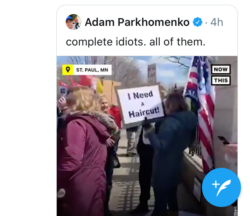 As many ‘Re-open the Economy’ protests have unfolded across the country in the last few weeks. Protesters are saying they want lockdowns to end, so they can get their hair cut and colored. But hair salons are not a business that is able to keep a safe social distance while performing job duties.
As many ‘Re-open the Economy’ protests have unfolded across the country in the last few weeks. Protesters are saying they want lockdowns to end, so they can get their hair cut and colored. But hair salons are not a business that is able to keep a safe social distance while performing job duties.
Dr. Debra Birx of the Federal Coronavirus Task Force response team said about Georgia salons reopening this week, “If there’s a way that people can social distance and do those things. Then, they can do those things. I don’t know how, but people are very creative.” It is unclear how Dr. Birx thinks a salon stylist can cut hair from six feet away, stylists argue.
“The natives are getting restless,” said Antonucci. “At our shop (in Warwick, N.Y), Talk of the Town, we are offering clients the option to pick up their color. I go down to the salon. I gather the color formula in one container. I put the peroxide in another container. I give them instructions, gloves, brushes, bowls, anything the client will need to color their own hair.
“After I leave. I call my client and tell them their order is ready and waiting outside the salon. My customers slide the money for the products, under the salon door,” Antonucci said. “Right now the owner is charging $30 for this service. We felt (the owner and salon employees), this is what was safest, for all of us right now. It might not be much, but at least we are helping customers and making a small amount of money from selling supplies. We are going to be one of the last businesses to reopen.”
When asked about how salon customer Lois Hennion felt about visiting her local salon, she had this to say:
Tips from the Pro’s
Talk of the Town hair salon in Warwick, N.Y is urging clients not to buy box hair colors from local drug stores. Box colors do not use the same scale as professional salons and they almost always lead to an orange-y disaster.
Box colors are a huge money-maker for salons. It costs more money to fix a messed up box color than if you had just left your hair alone in the first place. It falls under the category of corrective color, we charge hourly for that service and it is harder for us to fix says salon owner Nora Pipia.
If you are worried about being in public with your grey, there are other options for frustrated clients. Beauty supply stores carry aerosol sprays, mascara wands, and root concealers as a temporary fix. They wash out and have to be reapplied after every hair wash. These products are great for one time use. If you have an event or a big shopping day, a temporary grey cover-up may be the way to go.
Closure Impact: Magnify this job-loss statewide, nationwide, worldwide.
To get an idea of how the pandemic is impacting local areas, below is a story-map of all the salons in Warwick, N.Y; only one small farming community out-of-work. Magnify this job-loss statewide, nationwide, worldwide. It is unclear how many salons are closed countrywide, according to USA Today there are an estimated 1.3 million beautician businesses in the United States.
This demonstrates one community’s job loss in one single profession in a small community in New York State. The coronavirus is not just affecting one state, this pandemic is global. Job loss is widespread and small businesses are struggling to survive. A person infected with the coronavirus may recover from the illness in two to eight weeks. However, the economic, mental and societal impact will be felt around the world for decades to come.
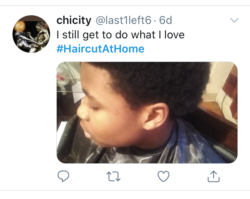
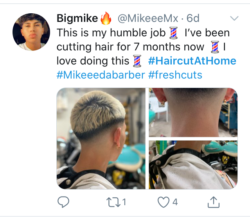
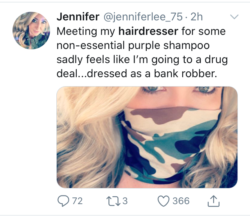
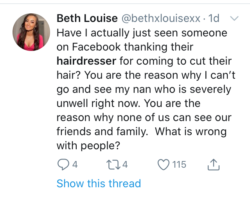
Leave a Reply
You must be logged in to post a comment.